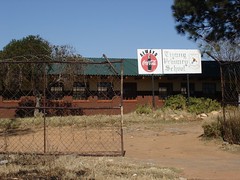Tuesday, June 27, 2017
Tuesday, June 21, 2016
ShackvilleTRC: An opportunity to turn the page
Very important article by Brian Kamanzi reflecting on student protests at this moment:
http://www.dailymaverick.co.za/opinionista/2016-06-08-shackvilletrc-an-opportunity-to-turn-the-page/#.V2gkUeZ95E7
Thursday, June 16, 2016
Thursday, March 25, 2010
50 Years On - Remembering March 21 1960: Robert Sobukwe and the Positive Action Campaign

Sources: 1. Historical Papers, Wits University, http://www.wits.ac.za/histp/sobukwe.htm
2. Pogrund P. (1990): How Can Man Die Better: The Life of Robert Sobukwe, Houghton Mifflin, South Africa.
Thursday, July 03, 2008
Tiyang Primary School: Meadowlands
The two-storey structure pictured above is a former WRAB Beer Hall (Bareng). The destruction of this beer hall was the final act of destruction by students from Meadowlands. Students were forced to scatter into nearby homes as police converged into the area.
This is where Maki's march ended. She returned to her home and was glad not be in school for the next few days.
Here is a short audio interview with Maki Lekaba:
Monday, June 30, 2008
We are loved
This seamless technological approach takes a back-seat though, to the well researched content. Farouk, who was the chief researcher, explored the routes with guides who told him the stories. Points of interest were photographed. On the map these photos and stories can be accessed by clicking on the spots. The contemporary photos provide an entry point both to the past events as well as urban history since. The result is an in-depth look at a significant historical moment, but which is easily understood and reached.Clearly, we're doing something right!
Thursday, December 06, 2007
Research Findings
- There are number of meeting places and social networks which provided support to the students during the planning stages of the uprisings. The house of Mr. Mbatha and Titi Mthenjana stand out in particular. Oupa Moloto is certain of the existance of further landmarks in White City, however he is struggling to remember where they are.
- Naledi demontrates a rich political history, which this research process has only touched on. There are a number of homes belonging to student leaders which still need to be located.
- The history of the conflicts between hostel dwellers and township residents presents an important perspective social dynamics within Soweto. The geographic proximately of Jabulani Hostels to the newly developed 1976 Heroes Acre presents an opportunity to communicate this historically important relationship to new visitors.
- There are a number of Important landmarks pertinent to Hector Pieterson’s childhood life which need to be identified. Hector’s creche, the local shop, Hector’s School and the swimming pool in Central Western Jabavu are all important landmarks in the historical landscape of 1976.
- Diepkloof also has a rich history that has rarely received attention. According to Steve Lebelo, Diepkloof offers an ideal terrain to examine how forms of extended social networks developing since mass resettlement of communities in the 1950s and strengthened by the unifying ideology of Black Consciousness during the 1970s, broke down in the face of new political identities.
- Research into the life of Mbuyiso Makhoba needs to be prioritised. Not much is known about this important person who was immortalised in Sam Nzima’s famous photograph.
- A small group of students from Vuwani Secondary School continued to march from Sizwe Stores to Orlando West. Their fate is still unknown.
- Limited information on the uprisings in Tshiawelo has restricted this project. Whilst the route from Vuwani Secondary School has been mapped, limited information and particiaption from active particiapnts has hampered the mapping of the route from Sekano Ntoane.

